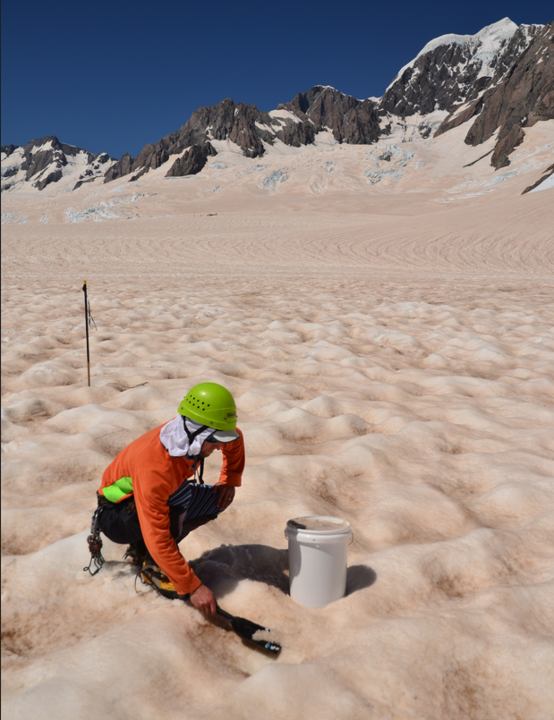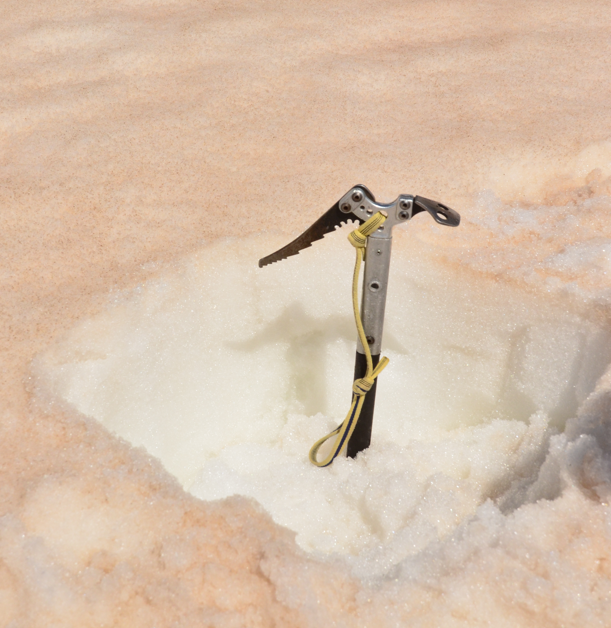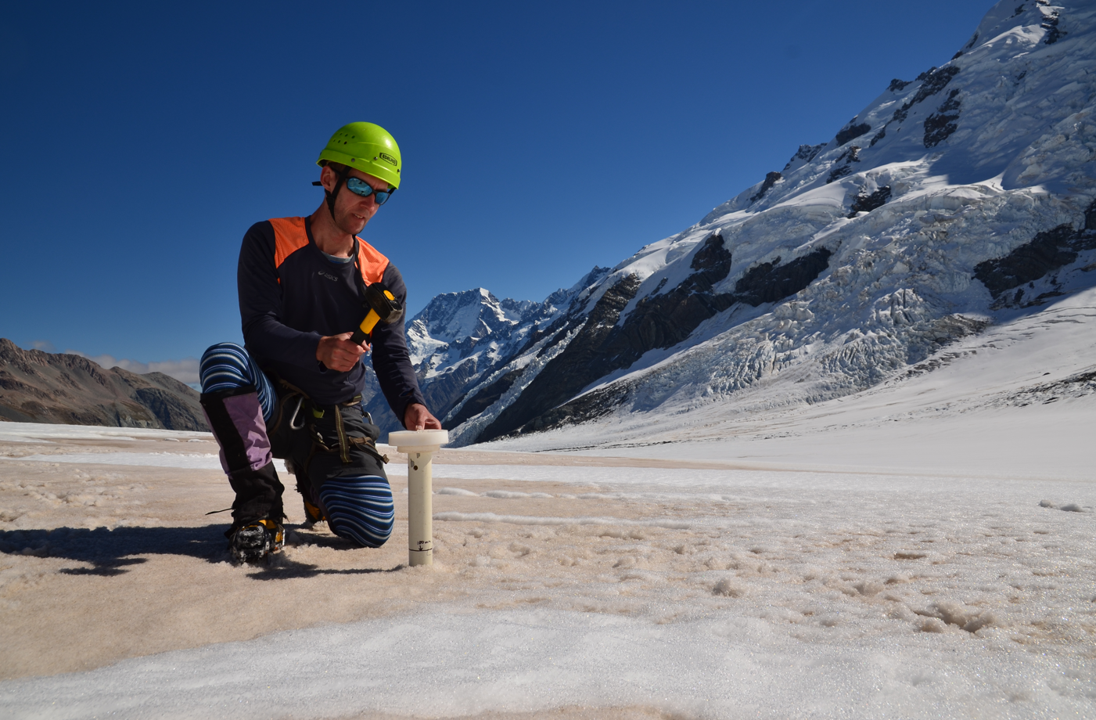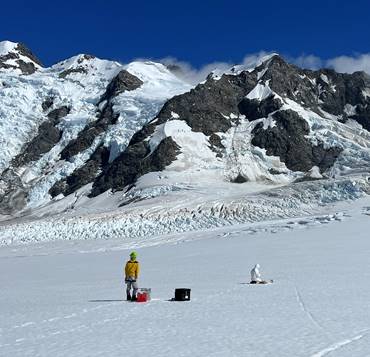Research
Published 3 July 2025Red Glaciers: the Answer to What’s Blowing in the Wind

A dramatic red dust blanket over Aotearoa New Zealand’s mountain glaciers could lead to increased melting. It was the outfall from raging wildfires in Australia - or was it?
Glaciers are supposed to look “white as snow” or “icy blue”. Yet, during the summer of 2019-2020, the glaciers in Kā Tiritiri o te Moana/the Southern Alps looked rather pinkish red and rusty brown. Red dust blanketed the snow fields and glacier tongues of Aotearoa New Zealand’s peaks. It was an extraordinary sight, and begged the question where the dust had come from and how it got there.
More than simply an engaging puzzle for curious scientists, the dust cover has serious impacts on its frozen bed. Pure snow and ice reflect most of the sun’s rays that hit them and are therefore able to stay cool. In contrast, the dust particles absorb the energy from the sun as heat, causing the snow and ice around them to melt. Dust containing black carbon, i.e., soot from wildfires or industry, is even worse because it reduces the reflectance of snow and ice even at concentrations that the eye cannot see. Our glaciers are in serious trouble from climate change already, having shrunk by about a third in the last 25 years. This loss is higher than almost anywhere else in the world, so that any additional process that causes melting is bad news indeed.
A Marsden funded research project set out to study where the dust had come from and what its impacts might be. The project was conceived and led by Dr Phil Novis and included scientists from Manaaki Whenua Landcare Research (MWLR), Te Herenga Waka Victoria University of Wellington (VUW), and Te Whare Wānanga o Waitaha University of Canterbury.

Sampling snow full of red dust high on the Fox Glacier; February 2020. Photo by John Hunt, MWLR.
There is no region of Aotearoa that could supply enough dust to blanket the Southern Alps. However, over in Australia, devastating bush fires had recently sent massive amounts of ash high into the air. Dramatically glowing night skies over Aotearoa showed that the winds had carried these particles across the Tasman Sea. Wildfire smoke and ash were therefore the main suspects for the dust cover on the glaciers.
The researchers applied a suite of scientific tools to pinpoint the source region and analyse the chemical make-up of the dust to verify its origin. They soon found that the wildfire explanation does not stack up. Time-lapse photographs of the Brewster Glacier, and satellite imagery from other parts of the Southern Alps, showed that the red dust arrived in November 2019 - before the blazes of the “New Year bushfires” had raged in Australia. Dr Holly Winton (VUW) then led geochemical analyses of dust from the Fox, Franz Josef, and Tasman Glaciers to “fingerprint” the particles. The team did find some of the telltale organic molecules that are produced in fires, but most of the dust turned out to be tiny rock fragments. The nature of the dust matched the geology of a region in south-east Australia.

A snow pit on the Fox Glacier shows that the dust is contained in the uppermost centimetres of the snow layer; February 2020. Photo by John Hunt, MWLR.
Having pinpointed the origin of the dust, the team then reconstructed the events that led to the striking colour change in the mountains of Aotearoa. In late 2019, high winds in desert regions of south-east Australia whipped up dust storms that suspended tiny sand particles in the air. These winds also drove bush fires, but not the devastating blazes that were to follow. The wider weather systems carried the dust across to Aotearoa. Dr Ben Jolly at MWLR specially developed a metric called the Red Dust Index, which the team applied to estimate that an astonishing 4,500 tonnes of dust were deposited on top of snow and ice in the Southern Alps in the 2019/2020 summer. Most of it fell during a two-week period in late November 2019. Fresh snowfall quickly buried the dust, but this surface snow melted away in early 2020 – at the same time that our skies were coloured by the New Year Australian wildfires. Now exposed, the mineral particles and their red colour reduced the albedo, i.e., the ability of snow to reflect sunlight.

Dr Novis revisiting the Tasman Glacier one year after the dust storms. Large parts of the glacier surface are still covered in the particles. Photo by John Hunt, MWLR.
Even though the dust storms lasted only a short time, they could have long-term effects on our glaciers. The 2019/2020 storm is not unprecedented; it is at least the ninth such event recorded in Aotearoa since 1902. However, it is one of the most dramatic. The Southern Alps may well see more of these massive dust deposits in coming years. This is due to climate change, which is expected to increase desertification and dry conditions in areas like Australia so that dust storms—as well as wildfires that can be driven by similar weather patterns—are likely to happen more often. Unfortunately, Aotearoa is right at the receiving end of dust blown across the sea when these events occur in Australia.

Study authors Holly Winton (VUW) and Phil Novis (MWLR) on a white Tasman Glacier during the 2022/2023 season. The team collected “clean” snow samples to investigate the influence of local dust sources. Photo supplied by Holly Winton, VUW.
This study is a major step forward in the scientific understanding of the weather patterns that expose glaciers to their unwelcome dirt covers. It combined multiple lines of evidence to overturn an obvious, but mistaken assumption as to the cause of a dramatic natural event. In a time when people use all kinds of information for their decisions, the research is a good example of how science can accurately determine the processes in our environment.
Glaciers are an integral part of the alpine ecosystem and environment; they are tourist attractions, water towers that supply lowlands with water throughout the summer, and their retreat creates risk of landslides and flooding. This project, part of a wider research programme on the effect of airborne particles on snow and ice melt, informs us what the future may hold for our valuable and vulnerable glaciers.
For more information, see the scientific article in Geophysical Research Letters,
and the Editor’s Highlight in EOS, marking it as an exemplary study.
Watch some aerial footage of the remarkable colour change on our glaciers, as well as the majestic landscape of the main divide of Kā Tiritiri o te Moana – Southern Alps:
Flight from Fox Glacier in an ascending circle over the top icefall. This shows the contrast between contaminated snow and blue-white glacier ice.
Flight over the upper Franz Josef Glacier across West Hoe Pass to the Fox Glacier. This shows the distribution of new, clean snow over the older dust-contaminated surface.
Videos by Phil Novis, MWLR
RESEARCHER
Dr Phil Novis
ORGANISATION
Manaaki Whenua Landcare Research
FUNDING SUPPORT
Marsden Fund
CONTRACT OR PROJECT ID
LCR2003
